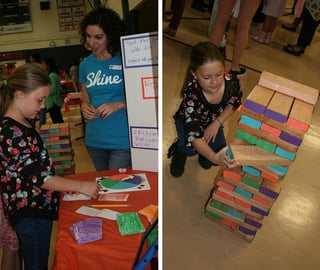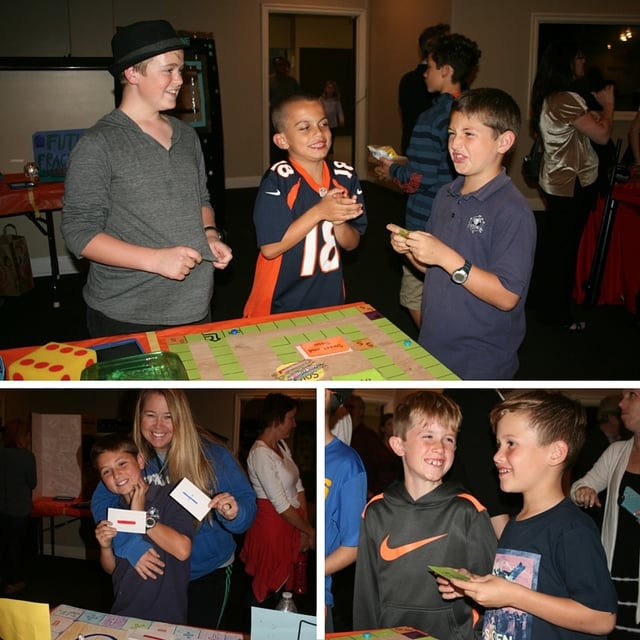
Research supports what teachers know instinctively – that what happens outside the classroom has significant bearing on students’ success in the classroom.
Education researchers have found that talking to children about numbers, playing board games, and even one’s own personal math anxiety can have a significant impact on children’s math performance in school.
“If parent math talk is important for children’s mathematical success, then adding opportunities for parents and their children to discuss numerical and spatial aspects of math throughout the school year should enhance children’s math achievement," wrote Talia Berkowitz and her colleagues in the magazine Science last year.
We recently participated in Capistrano Valley Christian Schools’ STEAM Night (science, technology engineering arts and math) which included a science fair, a live reptile exhibit, student art displays, engineering activities, student-created websites and videos, math games created by elementary school students with high school mentors, and ancient strategy games.
Their STEAM Night provided a great framework for engaging the whole family in STEM and STEAM education. A few key take-aways:
- Make it interactive. Science and math are not spectator sports, and the evening reinforced that. Almost every point in the evening required interaction: students explained their science experiments, students taught parents how to play math games their class developed, and even animal scat was available for visitors to carefully pick through and identify bones fragments.
- Encourage play. Games are a great way to make a STEAM night interactive, and to start conversations between parents and children about math and science topics. The games don’t even have to be obviously related to STEM. “All of the games with problem solving and strategy are math,” parent Betsy Hansen explained to another parent, as they played the ancient African game Tarumbeta.
- Showcase student work. The evening prominently featured students’ work like the math games that elementary students had created for the National K-12 Game-a-thon. Walter Rygiol, who’s second-grade daughter Sophia had helped create the game Castle Jam, was thrilled to show off her work to her dad. “She was very excited and talked about it at home,” Walter said. The games “give them a way to look at math differently,” he added. And of course, all the better if it’s interactive. (See #1.)
 Second-grader Sophia is exchited to share the the math game "Castle Jam" which her class developed.
Second-grader Sophia is exchited to share the the math game "Castle Jam" which her class developed.
- Involve older students as mentors. The school offered some high school students the opportunity to mentor elementary school students for 30 minutes once a week for a month. During that time, the mentors helped the younger students come up with and build a math game. “The younger kids are just really creative and full of ideas,” said Ben, a freshman who mentored third graders for their game Sour Sorry. “I like to teach them and see how their minds work.”
 Elementary school students play math games they designed, with their high school mentors and with their parents.
Elementary school students play math games they designed, with their high school mentors and with their parents.
Principal Tessa Samuelsen found that the mentor-mentee relationship extended outside of the classroom, as high school students started paying more attention to their younger schoolmates on campus, waving to them and showing up to an elementary school performance to support them. “High school kids don’t always understand what role models they are, and when they have those little eyes watching them, it helps them see themselves as role models,” Samuelsen said, “and at the same time provides real-world heroes for the elementary school kids.”
(One caveat: CVCS has a bit of an advantage here, because it houses its elementary, junior high and high school all on one campus.)
- Cross the curriculum. It wasn’t just science and math teachers who were engaged in planning for the evening. The junior high social science class was doing a unit on Africa, so they provided elaborate African masks as artwork to decorate the tables of the ancient African math games being showcased. This cross-collaboration also helped hold the evening together as a cohesive experience. As proud parents came to see their child’s artistic creation, they were also drawn in to play the ancient games and start discussions around strategy and game-play.
- Use centers. CVCS used brightly colored table clothes to color-code their activity centers, which were especially helpful for identifying activities that cross fields. For example, the blue tablecloth signified an engineering activity, where guests could challenge themselves to build the tallest tower out of plastic cups in sixty seconds. Orange tablecloths pointed out that the strategy games were related to math.
- Connect with outside organizations. No, CVCS doesn’t have its own reptile zoo. They invited outside organizations to provide additional elements to the STEAM night. This included MIND Research Institute, which collaborated on the Game-a-thon showcase and brought the African games exhibit. Don’t be afraid to ask your education and community partners to help.
 MIND team member Mike Limon introduces Capistrano Valley Christian School students to the ancient African game Tarumbeta.
MIND team member Mike Limon introduces Capistrano Valley Christian School students to the ancient African game Tarumbeta.
The National K-12 Game-a-thon runs through July 1, 2016. To learn more about how you can participate in the Game-a-thon as a family or school-based activity, click here.



 Second-grader Sophia is exchited to share the the math game "Castle Jam" which her class developed.
Second-grader Sophia is exchited to share the the math game "Castle Jam" which her class developed. Elementary school students play math games they designed, with their high school mentors and with their parents.
Elementary school students play math games they designed, with their high school mentors and with their parents. MIND team member Mike Limon introduces Capistrano Valley Christian School students to the ancient African game Tarumbeta.
MIND team member Mike Limon introduces Capistrano Valley Christian School students to the ancient African game Tarumbeta.
Comment